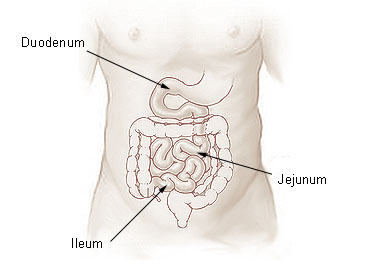jejunum

The jejunum is the second and largest section of the small intestine (comprising 2/5 of the total length), located between the duodenum and the ileum. The surface area of the lining of the jejunum is greatly increased by many small, finger-like outgrowths called villi. This makes it easier for digested material to be absorbed, which is the main function of the jejunum.
The word derives from the Latin jejunus, which means "empty of food" or "hungry." The ancient Greeks noticed at death that this part of the intestine was always empty of food.
Jejunal biopsy is removal of a piece of the mucosa (lining) of the jejunum. This can be done by a surgical operation but is usually performed by a gastroduodenoscope or a special metal capsule, swallowed by the patient. When the capsule is in the jejunum a small knife within it is triggered by suction on an attached tube, cutting off a small piece of mucosa. The specimen may be examined microscopically to assist in the diagnosis of celiac disease, Whipple's disease, or intestinal infections, or its enzyme content may be measured to detect, for example, lactase_deficiency.html">lactase deficiency.
Jejunectomy is surgical removal of all or part of the jejunum.
Jejunoileostomy is an operation in which the jejunum is joined to the ileum when either the end of the jejunum or the beginning of the ileum has been removed or is to be bypassed. It is usually performed for intestinal disease (e.g., Crohn's disease).


